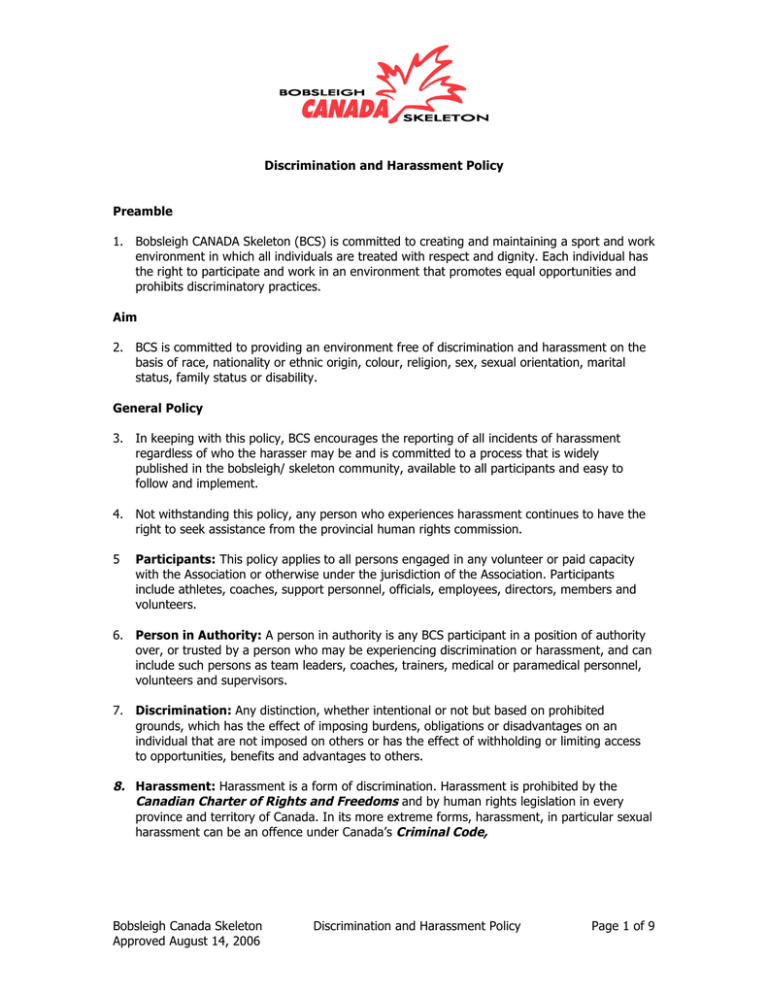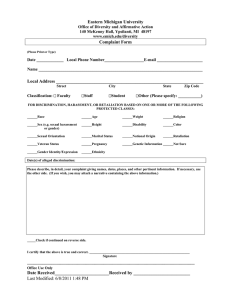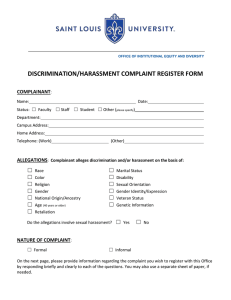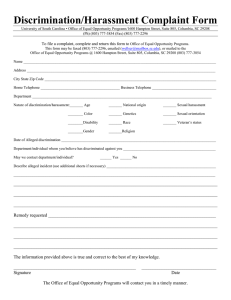
Discrimination and Harassment Policy
Preamble
1. Bobsleigh CANADA Skeleton (BCS) is committed to creating and maintaining a sport and work
environment in which all individuals are treated with respect and dignity. Each individual has
the right to participate and work in an environment that promotes equal opportunities and
prohibits discriminatory practices.
Aim
2. BCS is committed to providing an environment free of discrimination and harassment on the
basis of race, nationality or ethnic origin, colour, religion, sex, sexual orientation, marital
status, family status or disability.
General Policy
3. In keeping with this policy, BCS encourages the reporting of all incidents of harassment
regardless of who the harasser may be and is committed to a process that is widely
published in the bobsleigh/ skeleton community, available to all participants and easy to
follow and implement.
4. Not withstanding this policy, any person who experiences harassment continues to have the
right to seek assistance from the provincial human rights commission.
5
Participants: This policy applies to all persons engaged in any volunteer or paid capacity
with the Association or otherwise under the jurisdiction of the Association. Participants
include athletes, coaches, support personnel, officials, employees, directors, members and
volunteers.
6. Person in Authority: A person in authority is any BCS participant in a position of authority
over, or trusted by a person who may be experiencing discrimination or harassment, and can
include such persons as team leaders, coaches, trainers, medical or paramedical personnel,
volunteers and supervisors.
7. Discrimination: Any distinction, whether intentional or not but based on prohibited
grounds, which has the effect of imposing burdens, obligations or disadvantages on an
individual that are not imposed on others or has the effect of withholding or limiting access
to opportunities, benefits and advantages to others.
8. Harassment: Harassment is a form of discrimination. Harassment is prohibited by the
Canadian Charter of Rights and Freedoms and by human rights legislation in every
province and territory of Canada. In its more extreme forms, harassment, in particular sexual
harassment can be an offence under Canada’s Criminal Code,
Bobsleigh Canada Skeleton
Approved August 14, 2006
Discrimination and Harassment Policy
Page 1 of 9
Definitions of Harassment
9. Harassment is improper behaviour related to one or more prohibited grounds that are
offensive and which the person knew or ought to reasonably have known would be
inappropriate or unwelcome. The behaviour can be verbal or physical and can occur on a
one-time repeated or continuous basis. The person does not have to intend to harass for the
behaviour to be harassment.
10. Harassment can take many forms but generally involves conduct, comment or display that is
insulting, intimidating, humiliating, hurtful, demeaning, belittling, malicious, degrading or
otherwise cause offence, discomfort or personal humiliation or embarrassment to a person or
a group of persons.
Examples of harassment include:
a. Hostile verbal and non-verbal communications;
b. Unwelcome remarks, jokes, innuendo or teasing linked to a prohibited grounds such
as a person’s looks, body, attire, race, age, religion, sex or sexual orientation;
c. Condescending, paternalistic or patronizing behaviour linked to prohibited grounds of
discrimination which undermines self-esteem, diminishes performance or adversely
affects working conditions;
d. Practical jokes that cause awkwardness or embarrassment, endanger a person’s
safety or negatively affects performance;
e. Any form of hazing;
f. Use of terminology that reinforces stereotypes based on prohibited grounds of
discrimination
g. Acts of retaliation designed to punish an individual who has reported discrimination
or harassment;
h. Threats of retaliation designed to dissuade an individual from reporting discrimination
or harassment;
i. Racial or ethnic slurs.
11. Discipline in training is an indispensable part of high performance sport and should not be
confused with discrimination or harassment. However it is of vital importance that those in
authority:
a. Set and communicate non-discriminatory performance standards, selection criteria,
rules and regulations to all participants;
b. Be consistent in corrective or punitive action without discrimination or harassment
based on prohibitive grounds;
c. Use non-discriminatory terminology;
d. Address individuals by names and avoid the use of derogatory slang or offensive
terms.
Bobsleigh Canada Skeleton
Approved August 14, 2006
Discrimination and Harassment Policy
Page 2 of 9
12. In this policy sexual harassment means unwelcome sexual remarks or advances, requests for
sexual favours or other verbal or physical conduct of a sexual nature when:
a. Submitting to or rejecting the conduct is used as the basis for making decisions
which affect the individual;
b. Refusal to comply with a sexual-oriented request results in actual denial of an
opportunity, or an expressed or implied threat of denial of opportunity for such
refusal;
c. Such conduct has the purpose or effect of interfering with an individual’s
performance;
d. Such conduct creates an intimidating, hostile or offensive environment.
13. Sexual harassment may occur in the form of such conduct by males toward females,
between males, between females or by females towards males. Some examples of behaviour
which may be sexual harassment include:
a.
b.
c.
d.
Sexually degrading words to describe a person;
Criminal conduct such as stalking and physical or sexual assault or abuse;
The display of visual material which is offensive;
Unwelcome sexual flirtations, sexual remarks, advances, requests or invitations
whether direct or explicit;
e. Unwanted inquiries or comments about an individual’s sex life or sexual
orientation;
f. Derogatory or degrading remarks about a person’s sexuality or sexual
orientation.
Responsibilities of the People in Charge
14. Prevention and intervention are key to achieving a sport and work environment free of
discrimination and harassment. The BCS must represent a positive role model. BCS
participants should:
a. Communicate the BCS’s objective to create and maintain a sport and work
environment free of harassment and discrimination and with a view to
discouraging harassment;
b. Exercise good judgment and initiate appropriate action under this policy, if they
become aware that discrimination or harassment may have occurred;
c. Follow-up consultation with BCS management if discrimination or harassment is
suspected or rumoured, appreciating that individuals who experience
discrimination or harassment are often reluctant to report it.
15. The Executive, Board Members, the Managing Director are expected to contribute positively
to the development of an environment in which harassment does not occur.
The Executive Committee is responsible for:
a. Ensuring that investigation of formal complaints of harassment is conducted in a
sensitive, responsible and timely manner;
Bobsleigh Canada Skeleton
Approved August 14, 2006
Discrimination and Harassment Policy
Page 3 of 9
b. Imposing appropriate disciplinary or corrective measures when a complaint of
harassment has been substantiated, regardless of the position or authority of the
offender;
c. Supporting and assisting any employee or member of the BCS who experiences
harassment by someone who is not an employee or member of the BCS;
d. Ensuring that this policy is posted on the web-site and the information is
contained in a Handbook;
e. Appointing case review panels and appeal bodies and providing the resources
and support they need to fulfill their responsibilities under this policy;
f. Maintaining records as required under this policy.
Coach/ Athlete Sexual Relations
16. BCS takes the view that intimate sexual relations between coaches and adult athletes, while
not against the law, can have harmful effects on the individual athlete involved, on other
athletes and coaches and on BCS’s public image.
BCS therefore takes the position that such relationships are unacceptable for coaches
coaching or assisting in any way with a BCS National or Development Team. Should a sexual
relationship develop between an athlete and a coach, BCS will investigate, in accordance with
this policy and take action, where appropriate which could include reassignment or if this is
not feasible or appropriate, a request for resignation or dismissal from employment.
Disciplinary Action
17. Employees, members, volunteers or registrants of BCS against whom a complaint of
harassment is substantiated may be subject to discipline, according to the severity of the
substantiated conduct, up to and including dismissal from employment, termination of
membership or registration or a life time suspension from all bobsleigh/ skeleton activities
depending on the nature of the conduct.
Confidentiality
18. BCS understands that it can be extremely difficult to come forward with a complaint of
harassment and that it can be devastating to be wrongly accused of harassment. BCS
recognizes the interests of both the complainant and the respondent and, to the extent
practicable and appropriate under the circumstances will maintain confidentiality through the
process. However, if required by law to disclose information, BCS will do so.
Complaint Procedures
19. For the purpose of this section of the policy a person who experiences discrimination or
harassment is referred to as the “complainant” even where no formal complaint is filed.
20. All Bobsleigh CANADA Skeleton participants are encouraged to report suspected
discrimination or harassment. Such reports may be made to the Managing Director or the
President or to any other person in authority. All such reports shall be brought promptly to
the attention of the Managing Director or the President by whoever receives the report.
Bobsleigh Canada Skeleton
Approved August 14, 2006
Discrimination and Harassment Policy
Page 4 of 9
Assistance to Complainants
21. A complainant may request the assistance of the Managing Director in understanding these
policy guidelines. The Managing Director shall inform the complainant of:
a. The options to pursue an informal resolution of his/ her complaint;
b. The right to make a formal written complaint under this policy when an informal
resolution is inappropriate or not feasible;
c. The availability of support provided by BCS;
d. The confidentiality provisions of this policy;
e. The right to be represented by a person of choice at any stage in the complaint process
including legal counsel at the complainant’s own expense;
f. The right to withdraw from any further action in connection with the complaint at any
stage (even though BCS might continue to investigate the complaint);
g. Other avenues including the right to file a complaint with a human rights commission or
where appropriate, to contact the police to have them lay a formal charge under the
Criminal Code.
The Complaint
22. Although anyone may report discrimination or harassment, only persons affected by the
alleged discrimination or harassment or by the President on behalf of Bobsleigh CANADA
Skeleton may make a complaint.
23. A complaint shall be in writing and signed by the complainant or by the President if the
complaint is brought on behalf of Bobsleigh CANADA Skeleton or to any other member of the
Executive Committee of BCS if the complaint involves the President.
24. The complaint should include particulars of the discrimination or harassment, including
details of the incident or incidents, including dates, times, locations, description of action,
account of dialogue, the name of the perpetrator(s) and any witnesses or names of other
individuals who may also have experienced discrimination or harassment. The compliant
should detail any corrective action taken to date.
25. The parties to a complaint are Bobsleigh CANADA Skeleton, the respondent(s) and the
complainant(s).
Processing the Complaint
26. The person responsible for processing the complaint (hereinafter the “Bobsleigh CNADA
Skeleton Official”) shall be the President of Bobsleigh CNADA Skeleton, or where a
complaint involves conduct by the President, an alternate appointed by BCS Executive
Committee.
Bobsleigh Canada Skeleton
Approved August 14, 2006
Discrimination and Harassment Policy
Page 5 of 9
27. The President (or alternate) may delegate part or all of the President’s (or alternate’s)
responsibilities under these guidelines except to a person against whom the complaint
has been made.
Complaint Investigation
28. The Bobsleigh CANADA Skeleton Official may decide not to deal with a complaint:
a. If in the opinion of the Bobsleigh CANADA Skeleton Official the facts alleged in the
complaint would be insufficient, if proven, to establish discrimination or harassment
under the Bobsleigh CANADA Skeleton Policy or
b. If in the opinion of the Bobsleigh CANADA Skeleton Official, the investigation of the
complaint would not advance the purpose of the Bobsleigh CANADA Skeleton Policy in
the circumstances, because of a significant delay between the alleged events and the
time of the complaint.
29. In all other cases the Bobsleigh CANADA Skeleton Official shall investigate the complaint or
appoint and provide terms of reference to an investigator who shall investigate the complaint
and make findings of fact.
30. Before the investigation begins Bobsleigh CANADA Skeleton Official shall advise each
respondent of the complaint and shall provide each complainant and respondent a copy of
the written complaint, the Bobsleigh CANADA Skeleton Policy and these guidelines, and the
investigation terms of reference, if any.
31. Before the investigation report is issued, each respondent shall have a reasonable
opportunity to respond to the allegations. If a respondent declines to do so, or does not
respond within the time frame provided, the investigator’s report may nonetheless be issued.
32. All participants, including the respondent’s must cooperate fully in any investigation under
these guidelines.
33. The Bobsleigh CANADA Skeleton Official may consult with the investigator during the course
of the investigation, may review the investigation report in draft and may provide additional
terms of reference to, or request clarification from the investigator.
Assistance to Respondents
34. A respondent may request assistance of Bobsleigh CANADA Skeleton in understanding these
guidelines. Bobsleigh CANADA Skeleton shall refer the respondent to counseling upon
request, costs will be incurred by the respondent, and may explore the possibility of
alternative forms of dispute resolution with the respondent.
35 Should a respondent choose to retain legal counsel at any stage of a complaint or appeal, it
shall be at the respondent’s own expense.
Bobsleigh Canada Skeleton
Approved August 14, 2006
Discrimination and Harassment Policy
Page 6 of 9
Determination Following Investigation
1. The Bobsleigh CANADA Skeleton Official shall determine whether discrimination or
harassment has been established in light of the findings of fact contained in the investigation
report and if so, the nature and particulars of the discrimination or harassment.
Settlement
2. A complaint may be settled at any stage. A resolution agreement should be in writing and
signed by all parties.
Mediation
3. Bobsleigh CANADA Skeleton may provide a mediator, if the Bobsleigh CANADA Skeleton
Official views mediation as appropriate and if the complainant and respondent are willing to
enter a mediation agreement.
Disciplinary Sanctions
4.
When determining appropriate disciplinary action and corrective measures the Bobsleigh
CANADA Skeleton Official may consider factors including, but not limited to:
a. The nature of the discrimination or harassment;
b. Whether the harassment involved any physical contact;
c. Whether the discrimination or harassment was an isolated incident or part of an
ongoing pattern;
d. The nature of the relationship between the complainant and the respondent;
e. Whether the respondent has been involved in previous discrimination or
harassment incidents;
f. Whether the respondent admitted responsibility;
g. Whether the respondent retaliated against the complainant.
5.
In recommending disciplinary sanctions the Bobsleigh CANADA Skeleton Official may
consider the following options, singly or in combination, depending on the severity of the
harassment:
a.
b.
c.
d.
e.
f.
g.
h.
i.
A verbal apology;
A written apology;
A fine or levy;
Removal of certain privileges of membership or employment;
Temporary suspension with or without pay;
Termination of employment or contract; or
Expulsion from membership; or
Any other remedy as may be appropriate.
Within seven (7) days of receipt of the report from the Bobsleigh CANADA
Skeleton Official, the Executive Committee shall consider the recommendations
of the Bobsleigh CANADA Skeleton Official and make a decision as to the
appropriate sanction that shall be contained in the final report.
Bobsleigh Canada Skeleton
Approved August 14, 2006
Discrimination and Harassment Policy
Page 7 of 9
j.
The complainant will be informed of the outcome of the proceedings and of any
discipline or other action taken by the Executive Committee
Grounds for Appeal by Respondent(s)
a. A respondent(s) may appeal to the Executive Committee, the Bobsleigh CANADA
Skeleton Official’s determination only on the following grounds:
i. That the investigation was conducted in an unfair or biased manner
contrary to the rules of natural justice;
ii. That the findings of fact contained in the investigation report are
insufficient to support a determination that discrimination or harassment
has been established.
b. In an appeal by the respondent, the complainant shall be entitled to participate.
c. There shall be no appeal from any finding of fact contained in the investigation
report.
Grounds for Appeal by Complainants
a. A complainant may appeal to the Executive Committee, the Bobsleigh CANADA
Skeleton Official’s determination only on the following grounds:
i. That the investigation was conducted in an unfair or biased manner
contrary to the rules of natural justice;
ii. That the findings of fact contained in the investigation report ought to
have resulted in a determination that discrimination or harassment has
been established.
b. In an appeal by the respondent, the complainant shall be entitled to participate.
c. If the complainant is not satisfied with the outcome of the investigation or
appeal, the complainant will be reminded of the continuing right to file a
complaint with the provincial Human Rights Commission.
Notice of Appeal
a. The notice of appeal must be made in writing to Bobsleigh CANADA Skeleton
within fourteen (14) days of the appellant receiving notice of the Bobsleigh
CANADA Skeleton’s decision with respect to sanctions, and must state the
specific grounds for the appeal.
b. A copy of the notice of appeal shall be promptly provided to the President of
Bobsleigh CANADA Skeleton, if they are not involved as a participant in the case
and the Bobsleigh CANADA Skeleton Official involved with the case and to every
person entitled to participate as a respondent to the appeal.
c.
No member of the Executive Committee or the Board of Directors who had any
involvement in the complaint or who otherwise is in conflict of interest, shall
participate in the deliberations or decisions in the appeal.
d. The Appeal will be heard in compliance with the Bobsleigh CANADA Skeleton
Appeal Policy.
Bobsleigh Canada Skeleton
Approved August 14, 2006
Discrimination and Harassment Policy
Page 8 of 9
e. The Appeal Committee shall present its findings in a report to the Executive
Committee within ten (10).days.
f.
The Executive Committee shall have the right to accept, reject or vary the
recommendations of the Appeal Committee and issue a written report that shall
be the final decision of BCS.
g. A copy of the written report shall be provided, without delay to the complainant
and respondent and shall be retained in the files together with the Bobsleigh
CANADA Skeleton Official’s report and documentation.
Confidentiality
56.
To the extent possible, reports, complaints, witness statements and other documents
produced under these guidelines shall be held in confidence by Bobsleigh CANADA Skeleton.
However Bobsleigh CANADA Skeleton may make no absolute guarantees of confidentiality.
Circumstances in which information may be shared include:
a. When criminal conduct may be involved;
b. When It is felt to be necessary to protect others from harassment or
discrimination;
c. When required to ensure fairness or natural justices in the procedures
contemplated by these guidelines;
d. In the course of an investigation by a law enforcement agency;
e. To protect the interests of Bobsleigh CANADA Skeleton;
f. When required by law.
Bobsleigh Canada Skeleton
Approved August 14, 2006
Discrimination and Harassment Policy
Page 9 of 9



